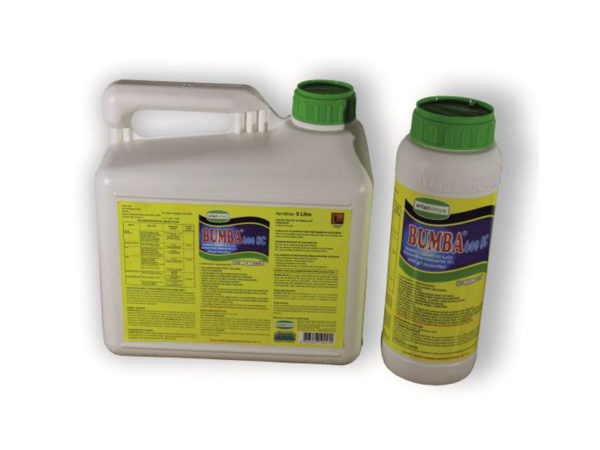

Explanation
PREPARATION OF THE PLANT PROTECTION PRODUCT FOR APPLICATION:
The plant protection product calculated over the recommended dosage is first mixed with some water in a separate container. The tank of the application machine is half filled with water. While the mixer of the machine is running, the mixture is added to the tank. The mixing is continued and the tank is completed with water. Mixing process continues until the application is completed. The prepared plant protection product should be used on the same day. The amount of water to be used per decare should be 20-40 liters, and fan jet nozzle should be used in applications.
Calibration:
Before the application, the calibration of the application machine should be done. Mixing amount should be adjusted to provide a good coating in applications. Applications should be done during the cool hours of the day under windless or less windy weather conditions.
CLEANING OF THE APPLICATION MACHINE:
Empty the application machine's tank safely immediately after the application is completed. After filling the tank with clean water, run the mixer and spray system to ensure all parts are washed. Do not wash near water sources. Do not discharge washing water and wastes into water sources.
HOW TO USE THE PLANT PROTECTION PRODUCT:
BUMBA 600 SC can be used safely in common chickpea varieties (Gökçe, Akçin, Sarı-98, Menemen-92, Damla, Aydın-92, Mediterranean and Central Anatolian native varieties). However, it should not be used because it is phytotoxic in some native varieties (like Diyarbakır) in the Southeastern Anatolia Region. Consult the company before using it in other varieties.
RESISTANCE MANAGEMENT:
Plant protection product named BUMBA 600 SC is a herbicide classified as Group F3.13 according to its mechanism of action. Repeated applications of plant protection products with the same mechanism of action promote resistance development. For this reason, to delay developing resistance, do not exceed the total number of applications of BUMBA 600 SC recommended in the same production season. In cases where the application should be repeated, pay attention to the use of plant protection products with a different mechanism of action (other than Group F3,13).
MIXTURE STATUS:
It is not recommended to mix with other plant protection products. If a mixture is needed, premix test should be done.
Rinse well by putting clean water up to ¼ in the empty packages of the product used. Pour the rinse water into the application tank. Repeat this process 3 times.
POISONING SYMPTOMS:
Slow reflexes, yellow color in urine.
FIRST AID MEASURES:
After Inhalation: The victim is brought to fresh air, kept warm and should not be moved. If you do not pass the complaints, see a doctor immediately.
After Skin Contact: Immediately take off any contaminated clothing. Wash the body parts of the medicine with plenty of water and soap for 15-20 minutes. If skin irritation persists, call a doctor. Wash contaminated clothing before using it.
After Eye Contact: Immediately wash the eyes and under the eyelids with plenty of water for 15 minutes. Remove contact lenses, if present. Get medical attention immediately.
After Swallowing: If swallowed, seek medical advice with the product label or this information form. Activated charcoal should be given. Never give anything by mouth to the unconscious patient and do not force them to vomit.
NATIONAL POISON CENTER “UZEM” TEL: 114
ANTIDOTE AND TREATMENT:
There is no special antidote known. The patient's stomach should be washed and treatment should be applied according to the symptoms.
CONTENTS:
aclonifen
HAZARDOUS EXPRESSIONS (H):
H302: Harmful if swallowed.
H317: Causes allergic skin reactions.
H318: Causes serious eye damage.
H351: Suspected of causing cancer.
H400: Very toxic in the aquatic environment.
H410: Long-lasting, very toxic effect in the aquatic environment.
Precautionary Statements (P):
P201: Read special instructions before use.
P202: Do not handle until all precautionary statements are read and understood.
P273: Avoid release to the environment.
P280: Wear protective gloves / protective clothing / eye protection / face protection.
P405: Store locked up.
P501: Dispose of contents / container in accordance with local regulations.
EUH208: Contains aclonifen. May cause an allergic reaction.
EUH401: Follow the instructions for use to avoid risks to human health and the environment.
MATTERS TO BE CONSIDERED WHEN USING AND STORING:
STORAGE STATUS:
When stored unopened in its original packaging under normal (cool and dry) conditions, there is no change in the physical, chemical and biological properties of the product outside the tolerance limits for 2 years.
| Plant Name | Harmful Organism Name | Administration dose
|
Time Between Last Application and Harvest |
| Sunflower (Before Exit) |
Red-rooted foxtail (Amaranthus retroflexus)
Darıcan (Echinochloa crus-galli) Ballıbaba (Lamium amplexicaule) Wild mustard (Sinapsis arvensis) Bird grass (Stellaria media) Slow motion (Veronica hederifolia) |
In broadleaf weeds: 200 ml / da
After sunflower planting, before emergence
|
—- |
| Sunflower (After Exit) |
Sirken-Iştır (Chenopodium album)
|
125 ml/da
In the period of 4-6 true leaves of weeds after emergence |
45-50 day |
| Carrot |
Red-rooted foxtail (Amaranthus retroflexus)
Wild purslane (Portulaca oleracea) Green hedgehog millet (Setaria viridis) Wild mustard (Sinapis arvensis) Donkey lettuce (Sonchus arvensis)
|
150 ml/da
After carrot planting before emergence |
—- |
| Chickpea | Sirken - Istir (Chenopodium album) Tongue Kanatan (Galium aparine) Ivy Shepherd Wand (Polygonum convolvulus) Small radish (Rapistrum rugosum) Wild mustard (Sinapis arvensis)
|
125 ml/da
2-4 true leaf period of weeds after emergence |
45-50 day |
| Spiny wild lettuce (Lactuca serriola) | 75 ml/da
2-4 true leaf period of weeds after emergence |
||
| Lentils (Before Exit) | Heart mustard (Myagrum perfoliatum)
Wild mustard (Sinapis arvensis) |
250 ml/da
300 ml/da
After lentil sowing before emergence |
—- |
| Lentils (After Exit) | Wild mustard (Sinapis arvensis) | 125 ml/da
2-4 true leaf period of weeds after emergence |
45-50 day |
| Heart mustard (Myagrum perfoliatum) Creeper shepherd wand (Polygonum convolvulus)
|
150 ml/da
2-4 true leaf period of weeds after emergence |
Sosyal Ağ